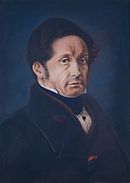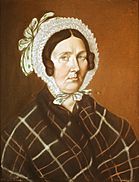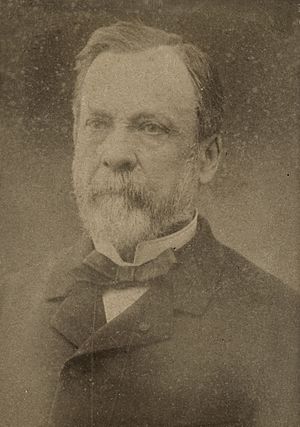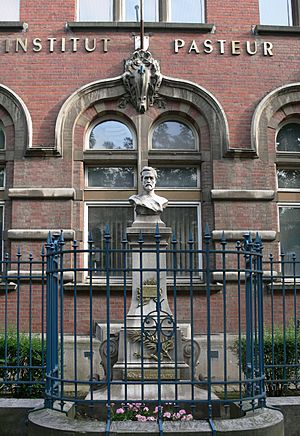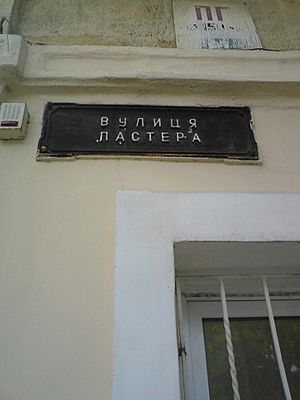Louis Pasteur facts for kids
Quick facts for kids
Louis Pasteur
|
|
|---|---|
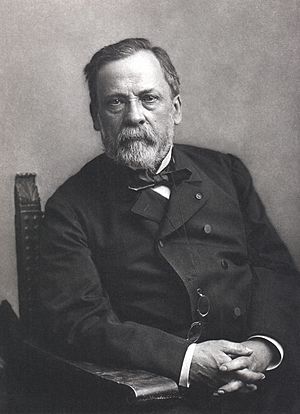
Photograph by Nadar
|
|
| Born | 27 December 1822 Dole, France
|
| Died | 28 September 1895 (aged 72) Marnes-la-Coquette, France
|
| Education | Mathematics, Docteur ès Sciences (Chemical Physics) |
| Alma mater | |
| Known for | Germ theory of disease Rabies vaccine Cholera vaccine Anthrax vaccines Pasteurization |
| Spouse(s) | |
| Children | 5 |
| Awards |
|
| Scientific career | |
| Fields | |
| Institutions |
|
| Notable students | Charles Friedel |
| Signature | |
 |
|
Louis Pasteur (born December 27, 1822 – died September 28, 1895) was a famous French chemist and microbiologist. He is known for his amazing discoveries about vaccination, how tiny living things cause fermentation, and a process called pasteurization. This last one was even named after him!
His work in chemistry led to huge steps forward in understanding what causes diseases and how to stop them. His ideas helped create modern hygiene, public health, and much of today's medicine. Pasteur's discoveries, especially his vaccines for rabies and anthrax, are believed to have saved millions of lives.
Many people see him as one of the main founders of modern bacteriology. He is often called the "father of bacteriology" and the "father of microbiology" alongside Robert Koch.
Pasteur was the director of the Pasteur Institute, which opened in 1887. He led it until he passed away. His body is buried in a special vault beneath the institute.
Early Life and Education
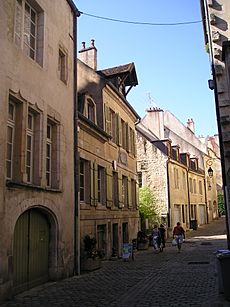
Louis Pasteur was born on December 27, 1822, in Dole, Jura, France. His family was Catholic and his father was a poor tanner. Louis was the third of five children. His family moved a few times when he was very young, settling in Arbois in 1827. He started primary school in 1831.
Pasteur went to secondary school at the Collège d'Arbois. In 1838, he tried to go to a boarding school in Paris, but he missed home too much and returned quickly.
In 1839, he joined the Collège Royal at Besançon to study philosophy. He earned his Bachelor of Letters degree in 1840. He then became a tutor at the Besançon college while studying science and mathematics. He didn't pass his first exam in 1841. However, he later earned his Bachelor of Science in Mathematics degree in 1842 from Dijon. His chemistry grade wasn't great, though.
In 1842, Pasteur tried to get into the École Normale Supérieure, a famous school in Paris. He passed the first tests, but his score was low. So, he decided to try again the next year. He went back to a Parisian boarding school to prepare. He also took classes at the Lycée Saint-Louis and attended lectures at the Sorbonne.
In 1843, he passed the entrance test with a much higher score and was accepted into the École Normale Supérieure. He earned his science degree in 1845. In 1846, he became a physics professor at the Collège de Tournon. But a chemist named Antoine Jérôme Balard wanted him back at the École Normale Supérieure as a lab assistant. Pasteur joined Balard and began his research on crystallography. In 1847, he presented two important research papers, one in chemistry and one in physics.
After a short time as a physics professor in Dijon in 1848, he became a chemistry professor at the University of Strasbourg.
Personal Life
While working in Strasbourg, Louis Pasteur met Marie Laurent, whose father was the university's head. They got married on May 29, 1849. They had five children together, but sadly, three of them died young from typhoid. Only two of their children lived to be adults.
Career Highlights
Pasteur became a chemistry professor at the University of Strasbourg in 1848 and was made the head of the chemistry department in 1852.
In 1854, he was named dean of the new science faculty at the University of Lille. This is where he started his important studies on fermentation.
In 1857, he moved to Paris to become the director of scientific studies at the École Normale Supérieure. He led the school from 1858 to 1867 and made many changes to improve science education.
He also held a position as a professor of geology, physics, and chemistry at the École nationale supérieure des Beaux-Arts from 1863 to 1867. In 1867, he became the head of organic chemistry at the Sorbonne, but he had to leave due to poor health. At his request, the École Normale opened a lab for physiological chemistry in 1867, and he directed it until 1888. In Paris, he founded the famous Pasteur Institute in 1887 and was its director for the rest of his life.
Amazing Discoveries
Molecular Asymmetry
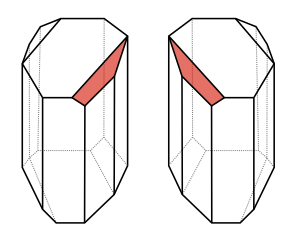
Early in his career, Pasteur studied a group of compounds called tartrates. He looked at their chemical, light-bending, and crystal properties.
In 1848, he solved a puzzle about tartaric acid. Pasteur noticed that tartrate crystals had tiny angled faces. He saw that half of the crystals were shaped like a right hand, and the other half were shaped like a left hand. When dissolved, the "right-handed" compound twisted light to the right, and the "left-handed" one twisted it to the left. Pasteur realized that the way the molecules were arranged inside the compound, in an uneven way, was causing the light to twist.
Some scientists believe this work was his "most important and original contribution to science."
Fermentation and Germ Theory
Pasteur became interested in fermentation while working in Lille. He began by checking the work of Theodor Schwann, who had shown that yeast was alive.
Pasteur's research proved that tiny living things, called micro-organisms, were responsible for making drinks like beer, wine, and milk spoil. Once he knew this, he created a process where liquids like milk were heated to a temperature between 60 and 100 degrees Celsius. This heat killed most of the bacteria and molds already in them. Pasteur patented this process in 1865 to stop wine from spoiling. This method became known as pasteurization, and soon it was used for beer and milk too.
Seeing how micro-organisms spoiled drinks led Pasteur to a big idea: that these tiny living things could also infect animals and humans, causing diseases. This idea, called the germ theory, led Joseph Lister to develop antiseptic methods for surgery, making operations much safer.
Silkworm Disease
In the mid-1800s, two diseases, pébrine and flacherie, were killing huge numbers of silkworms in southern France. This caused big losses for farmers. In 1865, Pasteur went to Alès and worked for five years to find a solution.
Silkworms with pébrine had tiny spots, or corpuscles, on them. At first, Pasteur thought these spots were just a symptom. But in 1870, he realized that these corpuscles actually caused the disease. He also found that the disease could be passed down from parent silkworms to their offspring. Pasteur created a way to stop pébrine: after female moths laid their eggs, the moths were crushed and examined under a microscope. If corpuscles were seen, the eggs were destroyed.
Pasteur also believed that bacteria caused flacherie. Today, we know viruses are the main cause. Flacherie could spread by accident or be passed down. Good hygiene could prevent accidental spread. To stop hereditary flacherie, only moths whose bodies were free of the disease-causing micro-organisms were used to lay eggs.
Disproving Spontaneous Generation
After his fermentation experiments, Pasteur showed that yeast naturally came from the skin of grapes. He found that sterilized grapes and grape juice never fermented on their own. He even used sterilized needles to get grape juice from under the skin and covered grapes with sterilized cloth. In both cases, no wine was produced in sterilized containers.
His findings went against a popular idea at the time called spontaneous generation. This idea claimed that living things could just appear from non-living matter. Pasteur did several experiments to prove this wrong. He put boiled liquid in a flask and let hot air in. When he sealed the flask, no organisms grew.
In another experiment, he opened flasks with boiled liquid. Dust entered, and organisms grew in some of them. He noticed that fewer organisms grew in flasks opened at higher altitudes. This showed that air at high altitudes had less dust and fewer organisms.
Pasteur also used special swan neck flasks filled with liquid that could ferment. Air could enter through a long, curving tube. Dust particles would get stuck in the curve. Nothing grew in the liquid unless the flask was tilted, letting the liquid touch the contaminated neck. This proved that living organisms came from outside, on dust, and didn't just appear from the liquid or the air itself.
These experiments were very important in showing that spontaneous generation was not true. Pasteur presented his findings to the French Academy of Sciences in 1881.
Immunology and Vaccination
Chicken Cholera Vaccine
Pasteur's first work on vaccines was for chicken cholera. He got samples of the bacteria (now called Pasteurella multocida) from Henry Toussaint. He started studying it in 1877 and, by the next year, could grow it steadily in broths. After another year of growing the bacteria, he found that it became less harmful. Some of his samples could no longer make healthy chickens sick.
In 1879, Pasteur was planning a holiday. He told his assistant, Charles Chamberland, to give the chickens a fresh bacteria culture. Chamberland forgot and went on holiday himself. When he returned, he injected the month-old cultures into healthy chickens. The chickens showed some signs of infection but, instead of dying, they fully recovered. Chamberland thought he had made a mistake and wanted to throw away the old culture, but Pasteur stopped him. Pasteur then injected these recovered chickens with fresh, strong bacteria that would normally kill other chickens. But these chickens didn't get sick! It was clear to Pasteur that the weakened bacteria had made the chickens immune to the disease.
In December 1880, Pasteur shared his results. He believed the bacteria became weaker when exposed to oxygen. He explained that bacteria kept in sealed containers stayed strong, but those exposed to air in culture media could be used as a vaccine. Pasteur called this weakening of the bacteria "attenuation."
Anthrax Vaccine
In the 1870s, Pasteur used this same idea to create a vaccine for anthrax, a deadly disease that affected cattle. He grew bacteria from the blood of animals with anthrax. When he injected these bacteria into other animals, they got anthrax, proving the bacteria caused the disease. Many cattle were dying in certain fields. Pasteur learned that sheep that died from anthrax were buried there. He thought earthworms might bring the bacteria to the surface. He found anthrax bacteria in earthworms' droppings, proving his idea. He told farmers not to bury dead animals in their fields.
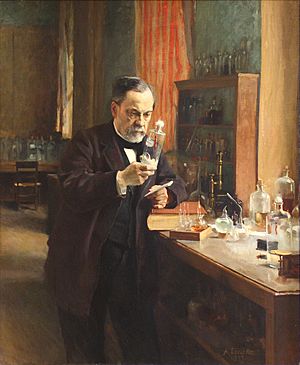
Pasteur found that anthrax bacteria were harder to weaken by air than chicken cholera bacteria because they formed spores. In early 1881, he discovered that growing anthrax bacteria at about 42 degrees Celsius stopped them from producing spores. On March 21, he announced he had successfully vaccinated sheep.
A public experiment was set up in May at Pouilly-le-Fort. Fifty-eight sheep, two goats, and ten cattle were used. Half of them received Pasteur's vaccine on May 5 and 17, while the other half were not treated. On May 31, all the animals were injected with a strong, deadly anthrax bacteria culture. On June 2, over 200 people watched the results. All the vaccinated sheep and goats survived, while the unvaccinated ones had died or were dying.
There were some disagreements with another scientist, Robert Koch, about the anthrax research. Koch had also done important work on anthrax. They had different ideas about how the bacteria worked and how to prepare the vaccine. They discussed their findings at scientific meetings and in papers.
Swine Erysipelas Vaccine
In 1882, Pasteur sent his assistant Louis Thuillier to southern France because of an outbreak of swine erysipelas, a disease affecting pigs. Thuillier found the bacteria that caused the disease in March 1883. Pasteur and Thuillier made the bacteria stronger by passing it through pigeons. Then, they passed it through rabbits, which weakened it and helped them create a vaccine.
Rabies Vaccine
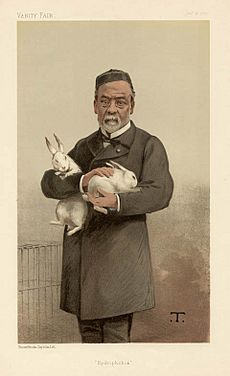
Pasteur created the first vaccine for rabies. He grew the rabies virus in rabbits, then weakened it by drying the infected nerve tissue. This vaccine was first tested on a 9-year-old boy named Joseph Meister on July 6, 1885. The boy had been badly bitten by a rabid dog. This was a risky step for Pasteur because he wasn't a licensed doctor. After talking with doctors, he decided to go ahead. Over 11 days, Meister received 13 injections, each with a virus that had been weakened for a shorter time. Three months later, Meister was healthy. Pasteur was celebrated as a hero.
His lab notes show that Pasteur had treated two other people before Meister. One survived but might not have had rabies, and the other died. Pasteur successfully treated another person, Jean-Baptiste Jupille, in October 1885. Later that year, many people, including four children from the United States, came to Pasteur's lab for the vaccine. In 1886, he treated 350 people, and only one developed rabies. The success of this treatment paved the way for many other vaccines. The first Pasteur Institute was also built because of this achievement.
Because of his work on germs, Pasteur encouraged doctors to clean their hands and equipment before surgery. Before this, few doctors or assistants did this. Other doctors like Ignaz Semmelweis and Joseph Lister had also started using hand sanitizing in the 1860s.
Awards and Honors
Pasteur received many awards for his important work. In 1853, he won 1,500 francs from the Pharmaceutical Society. The Royal Society of London gave him the Rumford Medal in 1856 and the Copley Medal in 1874 for his discoveries. He became a Foreign Member of the Royal Society in 1869.
The French Academy of Sciences gave him the Montyon Prize in 1860, the Jecker Prize in 1861, and the Alhumbert Prize in 1862 for proving that spontaneous generation was false. He was elected to the mineralogy section of the French Academy of Sciences in 1862. He later became the permanent secretary of the physical science section in 1887.
In 1873, Pasteur was elected to the Académie Nationale de Médecine. He also received the Albert Medal in 1882 and the Cameron Prize for Therapeutics of the University of Edinburgh in 1889. In 1895, he won the Leeuwenhoek Medal for his contributions to microbiology.
Pasteur was also honored by the French government with the Legion of Honour. He started as a Chevalier in 1853 and rose through the ranks, becoming a Grand Cross of the Legion of Honor in 1881, which is a very high honor.
Legacy and the Pasteur Institute
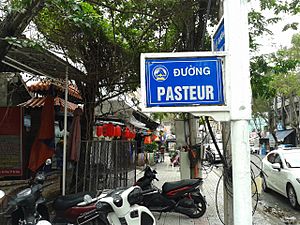
Many streets around the world are named after Louis Pasteur. You can find Pasteur Streets in places like Palo Alto in the US, Buenos Aires in Argentina, Great Yarmouth in the UK, Phnom Penh in Cambodia, and Ho Chi Minh City in Vietnam.
Both the Institut Pasteur and the Université Louis Pasteur were named after him. Schools like Lycée Pasteur in France and Lycée Louis Pasteur in Calgary, Alberta, Canada, also carry his name. Hospitals in South Africa and Košice, Slovakia, are named after him too.
A statue of Pasteur stands at San Rafael High School in California. A bronze bust of him is at the French Campus of Kaiser Permanente's San Francisco Medical Center.
The UNESCO/Institut Pasteur Medal was created 100 years after Pasteur's death. It is given every two years to recognize amazing research that helps human health.
A French academic, Henri Mondor, once said: "Louis Pasteur was neither a physician nor a surgeon, but no one has done as much for medicine and surgery as he has."
The Pasteur Institute
After creating the rabies vaccine, Pasteur suggested building an institute dedicated to it. In 1887, people from many countries donated money to build the Pasteur Institute. Its main goals were "the treatment of rabies using M. Pasteur's method" and "the study of dangerous and contagious diseases."
The institute officially opened on November 14, 1888. Pasteur brought together scientists from different fields. The first five departments were led by talented scientists who studied microbiology, hygiene, and disease. One year after it opened, one of his colleagues, Émile Roux, started the world's first microbiology course. Since 1891, the Pasteur Institute has grown, and today there are 32 institutes in 29 countries around the world.
Later Life and Death
In 1868, Pasteur had a serious stroke that paralyzed the left side of his body, but he managed to recover. In 1894, another stroke or kidney problem severely affected his health. He never fully recovered and passed away on September 28, 1895, near Paris.
He received a state funeral and was first buried in the Cathedral of Notre Dame. Later, his remains were moved to the Pasteur Institute in Paris. His vault there is covered with beautiful mosaics showing his many achievements.
Interesting Facts About Louis Pasteur
- Louis Pasteur had dyslexia and dysgraphia, which are learning differences.
- He was an average student when he was young. He wasn't especially focused on academics, as he loved fishing and sketching. He drew many portraits of his family and friends.
- Pasteur is considered one of the founders of the germ theory of diseases. His many experiments showed that diseases could be stopped by killing or preventing germs.
Images for kids
See also
 In Spanish: Louis Pasteur para niños
In Spanish: Louis Pasteur para niños


